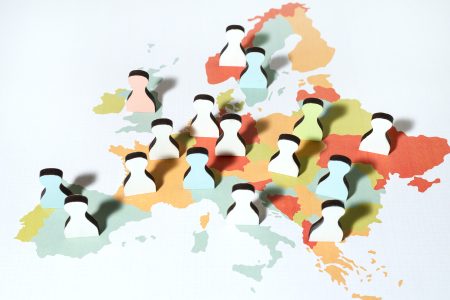
News
Cooperation
European transnational cooperation projects, your moment is now
The Interreg SUDOE and Euro-MED calls for proposals close between the end of May and mid-June, while the Atlantic call is scheduled for the fourth quarter of 2024
Over the past month the EU institutions have reached a partial political agreement on Horizon Europe, the Life Programme, the Connecting Europe Facility and the European Defence fund. These are now subject to formal approval by the European Parliament and Council.

A series of the agreements regarding some of the major financing instruments proposed by the European Commission: Horizon Europe, the Life programme, the Connecting Europe Facility and the European Defence Fund, have been successfully reached at the EU political level. A formal approval of these agreements by the European Parliament and the Council is now expected to be reached. Let’s explore what has been agreed in a bit more detail.
Horizon Europe
The Juncker Commission has once again stressed the importance of investing in research and innovation to find new solutions to maintain and improve the European way of life. It has set a new level of ambition to deepen Europe’s innovation capability, provide lasting prosperity and preserve the EU’s global competitiveness.
Building on the success of Horizon 2020, Horizon Europe will continue to drive scientific excellence through the European Research Council (ERC) and the Marie Skłodowska-Curie fellowships and exchanges, and will benefit from the scientific advice, technical support and dedicated research of the Joint Research Centre (JRC), the Commission’s science and knowledge service.
Furthermore, it will introduce new features including the European Innovation Council (EIC). The EIC, which is already running now in a pilot phase, will be a one-stop shop to bring disruptive and breakthrough innovations from lab to market application, and help start-ups and SMEs scale up their ideas. It will provide direct support to innovators through two main funding instruments, one for early stages and the other for development and market deployment. It will complement the European Institute of Innovation and Technology (EIT).
Life programme
In order to provide a better quality of life for Europeans and invest in a more sustainable future, the Juncker Commission is making an unprecedented effort to protect the environment and climate, notably by increasing the LIFE programme funding, and integrating climate action into all major EU spending programmes.
Supporting projects that deal with priorities like the clean energy transition, it will be one of the tools enabling the EU to meet its climate goals and seek to become climate-neutral by 2050. This will in turn help Europe to deliver on its commitments under the Paris Agreement and the United Nations Sustainable Development Goals, addressing some of the most important challenges of this century.
The LIFE programme is among the EU funding programmes for which the Commission has proposed the largest proportional increase for the period 2021-2027. Raising the level of ambition for climate financing, the Commission has also proposed that at least 25% of EU expenditure across all EU programmes should contribute to climate objectives.
In addition to its own direct achievements, the LIFE programme will act as a catalyst for other funds. The main elements of the new LIFE programme (2021-2027) include:
Connecting Europe Facility (CEF)
Echoing the same climate-neutral ambitions, mentioned under the Life programme, the Commission proposes additional funding tools to this aim through CEF to help EU transport support the Energy Union and clean energy transition.
In addition, the digital strand of CEF will finance strategic digital connectivity infrastructure. This will include 5G corridors for connected and automated mobility, terabit backbone networks linking high performance computers and their users, and gigabit connectivity for key socio-economic drivers (such as schools, hospitals, transport hubs, major public service providers and digitally intensive enterprises) and 5G-ready communities. All this will contribute to unlocking the next generation of Digital Single Market opportunities.
European Defence Fund
In his political guidelines in June 2014, President Juncker made strengthening European citizens’ security a priority. He announced the creation of a European Defence Fund in his 2016 State of the Union address. An agreement has now been found on the following key elements:
Next steps
The preliminary political agreement reached on all the funding programmes mentioned above by the European Parliament, Council and Commission in the so-called trilogue negotiations is now subject to formal approval by the European Parliament and Council. The budgetary aspects are subject to the overall agreement on the EU’s next long-term budget, proposed by the Commission in May 2018.

News
Cooperation
The Interreg SUDOE and Euro-MED calls for proposals close between the end of May and mid-June, while the Atlantic call is scheduled for the fourth quarter of 2024

Opinion
INNOVATION CONSULTING

Juan Cristóbal García
Senior Innovation Strategy Consultant

Publication
HORIZON EUROPE
In this document, our colleague Blanca Rodriguez shows us the keys to successfully writing a good Impact section.
Europe offers many opportunities to support and foster Research, Development and Innovation actions. Competition is high and being well positioned among stakeholders active in each sector requires a well thought-out plan of action and an active way of promoting visibility in Brussels.
We can help you with cascading funding, an EC mechanism that distributes public funding to help SMEs develop digital innovation.
We collaborate with public administrations to promote innovation and assist companies in integrating innovation into their overall strategy.
This website uses cookies so that we can provide you with the best user experience possible. Cookie information is stored in your browser and performs functions such as recognising you when you return to our website and helping our team to understand which sections of the website you find most interesting and useful.
Strictly Necessary Cookie should be enabled at all times so that we can save your preferences for cookie settings.
This website uses Google Analytics to collect anonymous information such as the number of visitors to the site, and the most popular pages.
Keeping this cookie enabled helps us to improve our website.
Please enable Strictly Necessary Cookies first so that we can save your preferences!
This website uses the following additional cookies:
(List the cookies that you are using on the website here.)
Please enable Strictly Necessary Cookies first so that we can save your preferences!